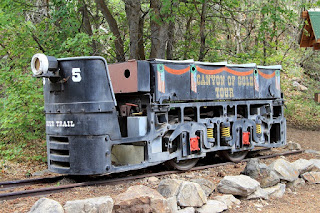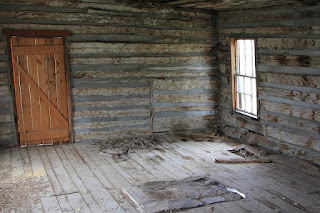Bullion Canyon is located several miles west of Marysvale (Utah) and is famous for its ATV trails and Canyon of Gold Driving Tour. The driving tour starts just west of the Fishlake National Forest boundary sign and the dirt road leading into the canyon is suitable for passenger cars when the road is dry; i.e., no rain or snow. Driving tour brochures are available on the internet, in Marysvale, and at the canyon entrance.
The first stop on the driving tour is at the beginning of the old Toll Road.
In 1869 a road into Bullion Canyon was constructed by some mining entrepreneurs and when the road was completed the builders set up a toll booth to collect a fee for using their road. However, the toll was so exorbitant that the miners quickly constructed a second road up the canyon and put the toll road out of business. You can still see sections of the old toll road on the north side of the canyon.
The three mining camps of Weber City, Virginia City and Bullion City were all located in Bullion Canyon and the remnants of all three camps are scattered throughout the canyon, so today it is difficult to determine where one camp started and the next camp ended. The tour brochure just provides general information about the structures, unless specific information is known.
The picturesque old Bully Boy Stamp Mill and Silo are located on private land, so I just photographed the ruins from the road. The silo is only a few feet off of the road, but the mill sits back farther into the woods.
At Miner's Park the Forest Service has reconstructed an old log cabin and furnished it with mining period items. There is also a lot of old mining equipment scattered around the cabin.
If you have a four-wheel drive vehicle you can continue up the canyon and then return to a paved road by various other trails. Or, you can follow the same road back down the canyon to Marysvale.
Robert Leroy Parker was born April 13,1866 in Beaver, Utah, and in 1879 the Parker family moved to a ranch south of Circleville (Utah). Robert's parents were Mormon pioneers from England and Robert was the oldest of 13 children. However, Robert was never much of a farmer, so in later years he formed the Wild Bunch Gang and changed his name to Butch Cassidy. As Butch Cassidy he had a much more lucrative career, until November 7, 1908, when he and the Sundance Kid met their demise in San Vicente, Bolivia.
Robert's boyhood home is located on the west side of Utah Heritage Highway 89 two miles south of Circleville. The land is privately owned, but the owner allows the public to visit the homestead and enter the cabin during certain seasons of the year.
There is a very nice Veteran's Memorial at the City Park in Circleville. The monument contains the names of local people killed defending their country and an inscription on the monument reads "Freedom is not Free."
In Junction (Utah) you can sleep in a courthouse without being incarcerated.
The Old Piute County Courthouse was constructed in 1903 and has now been converted into a Family Reunion Vacation Rental property that contains 8 bedrooms, 4.5 baths, and a complete kitchen facility. There are beds for 23 people and additional people can bring sleeping bags and bunk on the floor.
The historic John and Ella Morrill House, a unique example of the Victorian Gothic Style of architecture, is located adjacent to the Courthouse, but it is privately owned and not open to the public.
In 1898 JC Penney started working for the Golden Rule store chain and then in 1902 he opened his first Golden Rule store in Kemmerer, Wyoming. In 1903 he opened his second store in Marysvale (Utah). In 1907 JC Penney purchased the Golden Rule chain and then changed the store names to JC Penney. Thus, the people in Marysvale claim that the second JC Penny store built in the world is located in Marysvale.
The original store is now home to Lessie and Charlie's Rag Rugs, Quilts & Creative Arts. All handcrafted items sold in the store are made in the USA, mostly from Utah artisans.
If you are over 60 years of age, you probably remember the song "Big Rock Candy Mountain" that Burl Ives mad famous in the 1950s. The famous mountain actually exists a few miles north of Marysvale on the west side of Utah Heritage Highway 89.
After the song was released, the Big Rock Candy Mountain became one of the most recognized geological sites in Utah -- people came from all over the world to see the mountain that the song describes. However, most of the younger generation has never heard of the song and now the mountain's location is being removed from many road maps.
The mountain was formed millions of years ago when erupting volcanoes deposited large volumes of lava and ash more than 3,000 feet deep in the area. Then, through a complex chemical process the volcanic rock was altered and the colors that exist today are a result of mineralization. The yellow, orange, and red colors are a result of iron minerals and the white color is from potassium. Where is Burl Ives when we need him?
In July 2013 the Carpenter fire burned substantial portions of the wooded areas on Mount Charleston, causing the U.S. Forest Service to close many of the higher elevation trails. Since that time, most of the trails have reopened, except the Mount Charleston South Loop Trail that is scheduled to reopen in 2016, the South Loop Griffith Peak Trail that is scheduled to reopen in 2018, and the Harris Springs-Griffith Peak trail that is scheduled to reopen in 2020. Since I have no idea where I will be in 2020, I decided to include a RonnieAdventure Classic (Number One Son came up with that name.) of the Harris Springs-Griffith Peak trail.
Griffith Peak at 11,056 feet is the third highest peak in southern Nevada and historically almost everyone that wanted to summit Griffith Peak used the South Loop Trail. Since we had previously been to the peak using the South Loop Trail, we asked Kolohe to drop us at the Harris Springs trailhead and then drive around the mountain and pick us up a the South Loop Trailhead. She was not overly excited about the idea because it is a four-wheel drive trip to Harris Springs that includes some narrow, steep grades that are only wide enough for one vehicle at a time. We finally convinced her that the trailhead was so remote that she would never meet another vehicle and she could just dive slowly in four-wheel drive. She reluctantly agreed.
Things went well up the mountain to the Harris Springs Trailhead, so we turned the vehicle around and then started up the trail while Kolohe started back down the mountain road in four-wheel drive. We had a really great hike up to Griffith Peak and then went down the other side, where we found Kolohe waiting for us.
Unfortunately, we learned that on the way down the mountain Kolohe met another vehicle in the steepest, narrowest part of the trail. After saying some not too nice of things about us, the other vehicle was able to back down the trail until they found a spot in the trail that was wide enough for the two vehicles to pass. The rest of her journey was uneventful. Three cheers for Kolohe!!!



























































